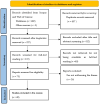Evaluating Exoskeletons for WMSD Prevention: A Systematic Review of Applications and Ergonomic Approach in Occupational Settings
- PMID: 39767533
- PMCID: PMC11675588
- DOI: 10.3390/ijerph21121695
Evaluating Exoskeletons for WMSD Prevention: A Systematic Review of Applications and Ergonomic Approach in Occupational Settings
Abstract
This review provides a comprehensive analysis of studies investigating the impact of occupational exoskeletons on work-related musculoskeletal disorder (WMSD) risk factors. The primary objective is to examine the methodologies used to assess the effectiveness of these devices across various occupational tasks. A systematic review was conducted following the PRISMA guidelines, covering studies published between 2014 and 2024. A total of 49 studies were included, identified through searches conducted in Scopus and Web of Science databases, with the search string launched in August 2024. The review identifies a growing body of research on passive and active exoskeletons, with a notable focus on laboratory-based evaluations. The results indicate that direct measurement and self-report methods are the preferred approaches in these domains. Ergonomic limitations and user discomfort remain concerns in some cases. The findings of this review may influence stakeholders by providing insights into the potential benefits of adopting exoskeletons and improving workplace ergonomics to reduce WMSD risks. Additionally, the identification of WMSD assessment methods will be valuable for validating the use of these technologies in the workplace. The review concludes with recommendations for future research, emphasizing the need for more real-world assessments and improved exoskeleton designs to enhance user comfort and efficacy.
Keywords: WMSD; ergonomics; exoskeleton; occupational settings; risk assessment methods.
Conflict of interest statement
The authors declare no conflicts of interest.
Figures






Similar articles
-
Ergonomic design and training for preventing work-related musculoskeletal disorders of the upper limb and neck in adults.Cochrane Database Syst Rev. 2012 Aug 15;2012(8):CD008570. doi: 10.1002/14651858.CD008570.pub2. Cochrane Database Syst Rev. 2012. Update in: Cochrane Database Syst Rev. 2018 Oct 23;10:CD008570. doi: 10.1002/14651858.CD008570.pub3. PMID: 22895977 Free PMC article. Updated.
-
Economic evaluations of ergonomic interventions preventing work-related musculoskeletal disorders: a systematic review of organizational-level interventions.BMC Public Health. 2017 Dec 8;17(1):935. doi: 10.1186/s12889-017-4935-y. BMC Public Health. 2017. PMID: 29216849 Free PMC article.
-
Health professionals' experience of teamwork education in acute hospital settings: a systematic review of qualitative literature.JBI Database System Rev Implement Rep. 2016 Apr;14(4):96-137. doi: 10.11124/JBISRIR-2016-1843. JBI Database System Rev Implement Rep. 2016. PMID: 27532314
-
Cost-effectiveness of using prognostic information to select women with breast cancer for adjuvant systemic therapy.Health Technol Assess. 2006 Sep;10(34):iii-iv, ix-xi, 1-204. doi: 10.3310/hta10340. Health Technol Assess. 2006. PMID: 16959170
-
Comparison of the effectiveness of inhaler devices in asthma and chronic obstructive airways disease: a systematic review of the literature.Health Technol Assess. 2001;5(26):1-149. doi: 10.3310/hta5260. Health Technol Assess. 2001. PMID: 11701099
Cited by
-
Assessing Transparency of Robots, Exoskeletons, and Assistive Devices: A Systematic Review.Sensors (Basel). 2025 Jul 17;25(14):4444. doi: 10.3390/s25144444. Sensors (Basel). 2025. PMID: 40732572 Free PMC article. Review.
References
-
- Russo F., Di Tecco C., Fontana L., Adamo G., Papale A., Denaro V., Iavicoli S. Prevalence of Work Related Musculoskeletal Disorders in Italian Workers: Is There an Underestimation of the Related Occupational Risk Factors? BMC Musculoskelet. Disord. 2020;21:738. doi: 10.1186/s12891-020-03742-z. - DOI - PMC - PubMed
-
- Williams A., Kamper S.J., Wiggers J.H., O’Brien K.M., Lee H., Wolfenden L., Yoong S.L., Robson E., McAuley J.H., Hartvigsen J., et al. Musculoskeletal Conditions May Increase the Risk of Chronic Disease: A Systematic Review and Meta-Analysis of Cohort Studies. BMC Med. 2018;16:167. doi: 10.1186/s12916-018-1151-2. - DOI - PMC - PubMed
-
- European Agency for Safety and Health at Work. de Kok J., Vroonhof P., Snijders J., Roullis G., Clarke M., Peereboom K., van Dorst P., Isusi I. Work-Related Musculoskeletal Disorders: Prevalence, Costs and Demographics in the EU. European Health; Luxembourg: 2019.
-
- Hagberg M., Violante F.S., Bonfiglioli R., Descatha A., Gold J., Evanoff B., Sluiter J.K. Prevention of Musculoskeletal Disorders in Workers: Classification and Health Surveillance—Statements of the Scientific Committee on Musculoskeletal Disorders of the International Commission on Occupational Health. BMC Musculoskelet. Disord. 2012;13:109. doi: 10.1186/1471-2474-13-109. - DOI - PMC - PubMed
-
- Colim A., Faria C., Braga A.C., Sousa N., Carneiro P., Costa N., Arezes P. Towards an Ergonomic Assessment Framework for Industrial Assembly Workstations—A Case Study. Appl. Sci. 2020;10:3048. doi: 10.3390/app10093048. - DOI
Publication types
MeSH terms
Grants and funding
LinkOut - more resources
Full Text Sources
Medical

